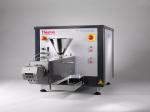ABSTRACT
This report describes the correlation between measurements done on a laboratory mixer with PVC Dry Blends and their processing behaviour on a counter-rotating twin screw extruder.
Introduction
On July 1st, 2006, the EU Directive 2002/95/EG (RoHS-Directive, Restriction of Hazardous Substances“) was put into force. It restricts producing and trading of products containing i.e. lead, mercury and cadmium.
Because a lot of PVC compounds still contain lead as stabilising media, there is urgency for the PVC industry to replace these stabilisers by less dangerous materials like CaZn stabilisers.
Changing the formulation of a PVC compound by using a new stabiliser, always takes the risk that also the production behaviour will change. The reason behind this is the fact that stabilisers also work as a lubricant. So the change of stabilisers will influence the fusion behaviour of the PVC compound. To make sure that the PVC compound keeps its processing properties it is necessary to adapt the whole compound formulation.
The most common tool to check the fusion behaviour of PVC compounds is the laboratory mixer test. It is an easy and reliable method to characterise the fusion and degradation behaviour of PVC compounds.
The samples used for this investigation were three PVC Dry Blends with new lead free formulations.
A complete copy of this application note is available by requesting LR-60.

